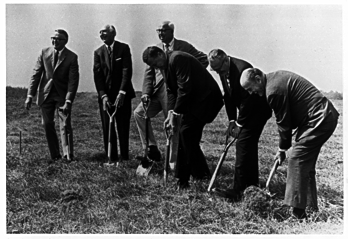Chapter 9: Origins of Hampshire Institutions
* Statement at Groundbreaking. (1968)
* The Motto Memo. (1968)
* The Tree of Hampshire College. (1968)
Groundbreaking at Hampshire College, Sept. 24, 1968
Left to right: Franklin Patterson, President of Hampshire College; Harold F. Johnson, Chairman of the Board of Trustees, Hampshire College; Thomas Mendenhall, President of Smith College; Calvin Plimpton, President of Amherst College; John W. Lederle, President of the Univ. of Mass.; Richard Gettell, President of Mount Holyoke College.
Statement by Harold F. Johnson at groundbreaking
Sept. 24, 1968
I tend to think of this occasion as a part of the agricultural process--the breaking of the ground--the sowing of the seed--the cultivation of the crop--and the harvest. However, the harvest will not be the splendid buildings, which will rise from these foundations. Those will be but the stalks that bear the grain. The harvest will be the young people, who on this ground will grow in stature and mature into well-formed, well-rounded human beings.
As was said on another occasion--the world will little note nor long remember what we say or do here--but I believe that the procession of young men and women, who are nurtured on this ground and who--year after year--move out from here into the stream of life--truly educated through the ministrations of Franklin Patterson and his associates and their successors--young people with their faculties aroused and their imaginations touched--will be a beneficent influence on the life of this country and of the world.
The Motto Memo
by Winthrop S. Dakin, May 1, 1968
The December trustees' meeting voted that I elaborate "Sapientia non sufficit," sprouting from the line of a sonnet by Santayana: "It is not wisdom to be only wise."
Pat and I have probed Latinists. "Sapientia" is not the word; it imports a glorious combination of knowledge, wisdom, conduct and attitude, in short something not to be disparaged. "Sufficit" is ponderous.
"Scientia non satis est" tentatively emerged--"Knowledge is not enough." But that would too readily be transliterated into "Science is not satisfactory."
Hoping to avoid such clamminess and also to suggest rather than chisel a thought, I propose "Non satis scire"--"To know is not enough." The "is" (est) is implicit. As the thought itself is "non satis" it nudges the imagination a bit. Its grammar has scholarly approval and its brevity virtue.
This is too negative say some. Try, e.g. "Bonum scire, melius sapere"--"Good to know, better to be wise." That, though positive, is flat and nudges not.
Also, some ask, why not English? Latin being dead its words do not change in meaning, become unstylish, respelled or slang for something unintended. They stay fresh.
The Tree of Hampshire College
April 12, 1968
To: Franklin Patterson
From: John Boettiger
Subject: The Tree of Hampshire College
I've had in mind for some time a question for you: do you know what inspired Eric, or what he intended, in drawing the tree that adorns our published working papers and briefs? The aspect that struck me as particularly interesting was the two leaves, apart from the rest, leaning toward the ground--offering, perhaps, a hint of fall and the natural cycle of life.
In any event, I recently came across a variety of very early--Mesopotamian--representations of the Tree of Life that bear a strong similarity to Eric's design. The two downward-leaning branches, though, bear not leaves but the fruit of the tree--in rather the same shape as Eric's leaves. Potent fruit--to nurture more than knowledge (Genesis 3:22-24). And the tree, a universal symbol of that which the College exists to manifest and serve; in short, to use a good phrase of Joseph Campbell, the College's "mythic identification."
What would you think of a small alteration, then, making the two lower leaves into fruit simply by erasing the extended stem of both, and adopting, as a positive counterpart of our College motto, the symbolization of the Tree of Life?

